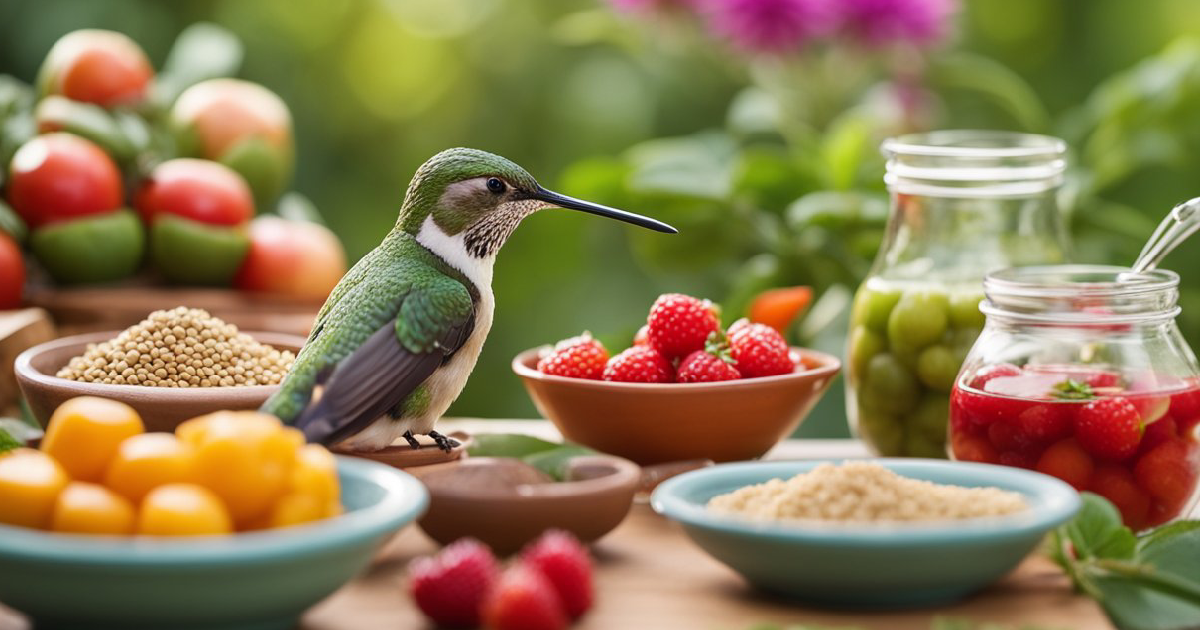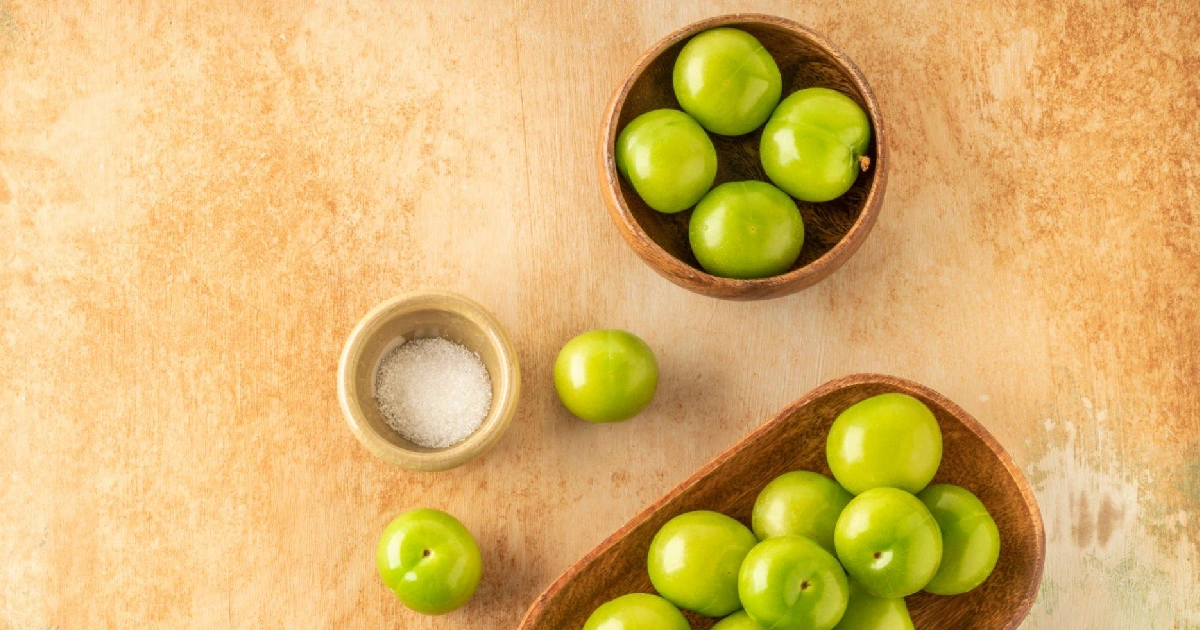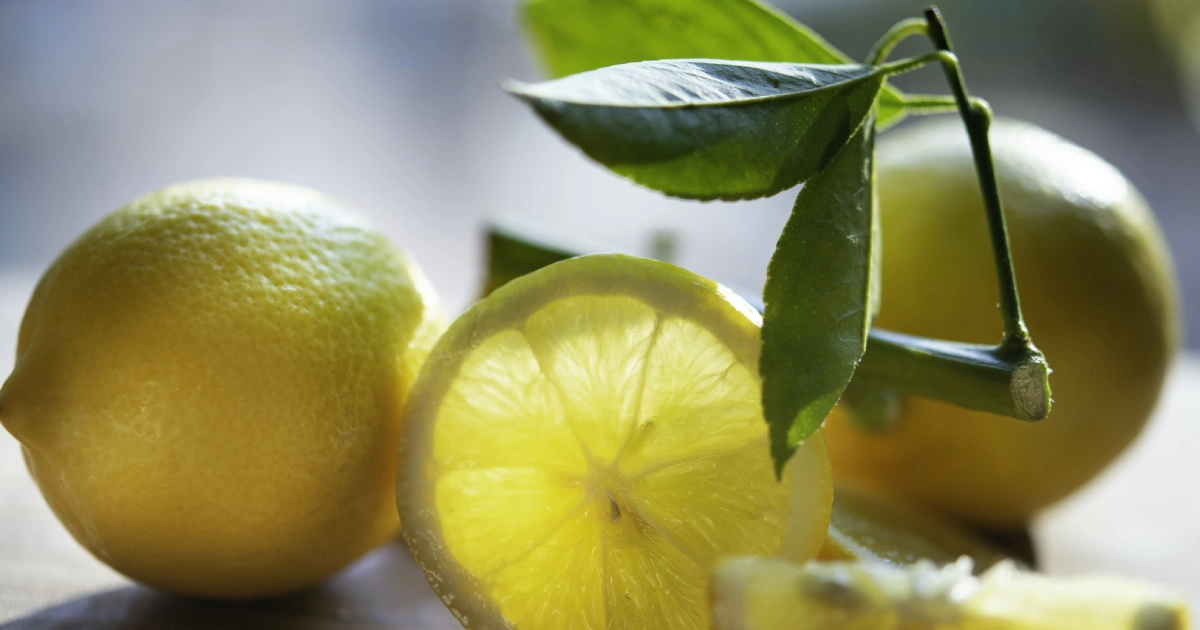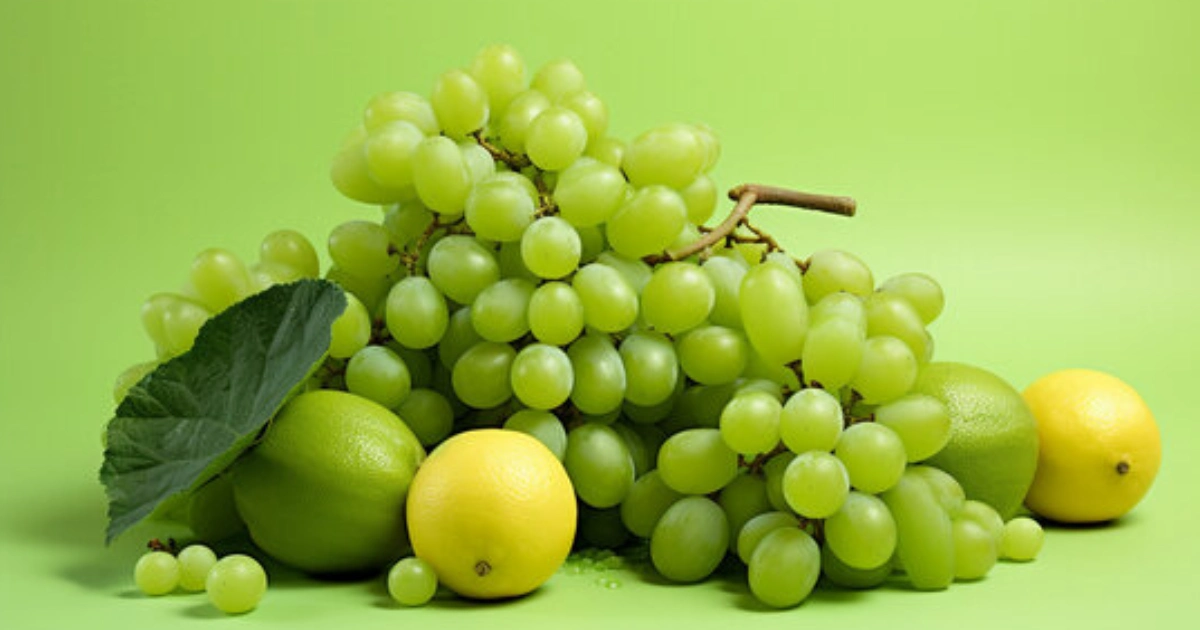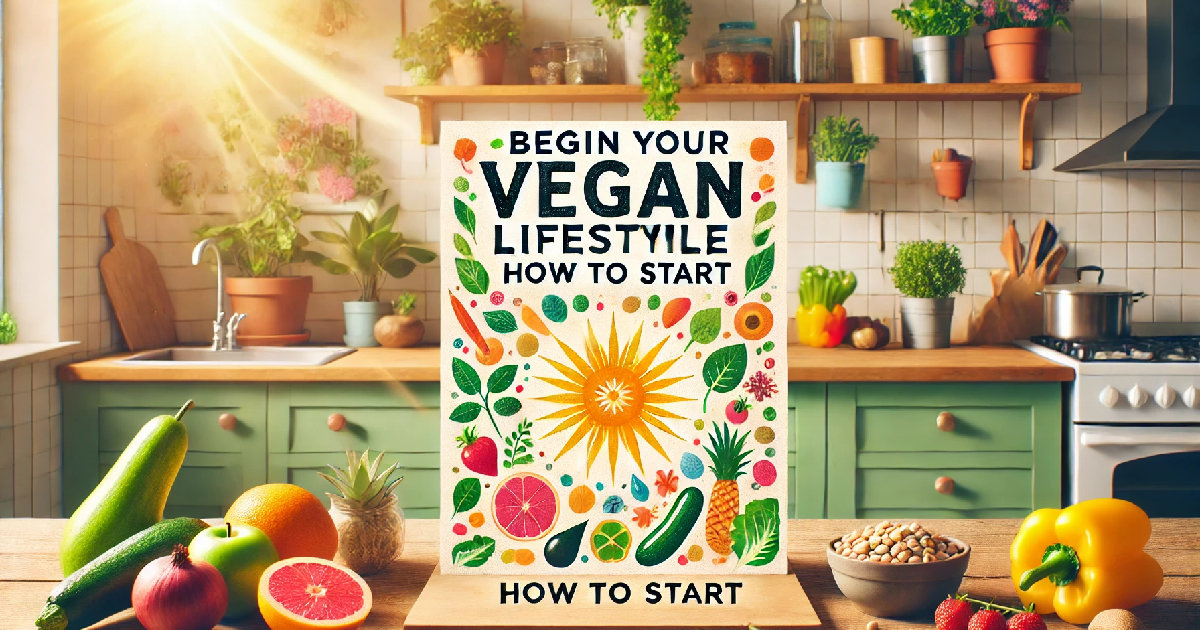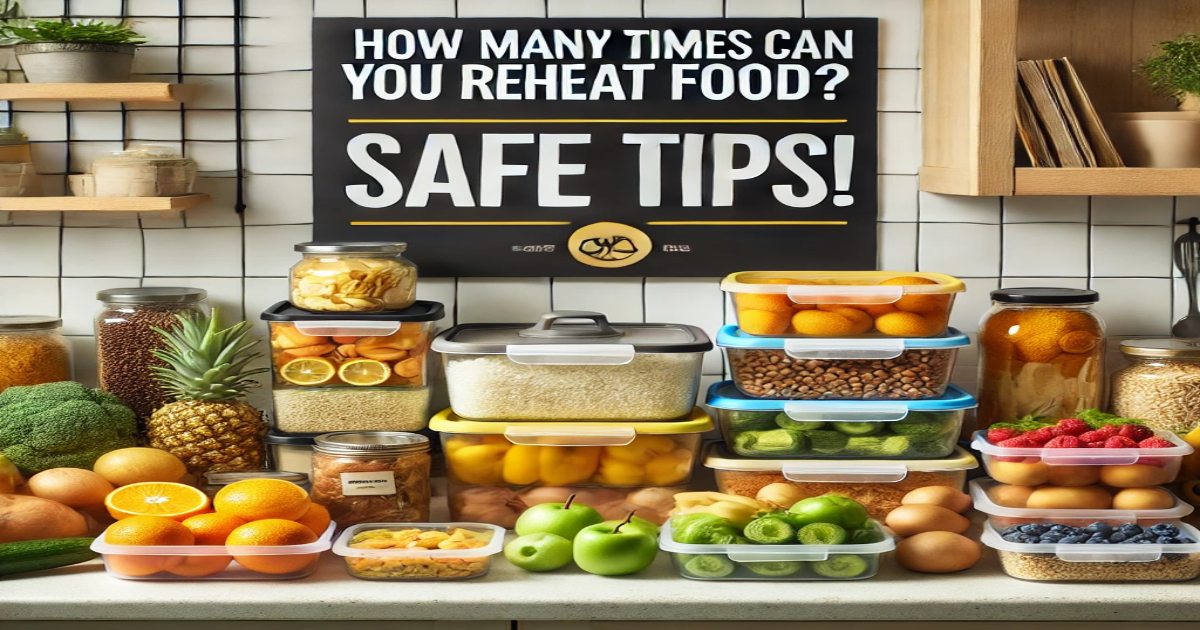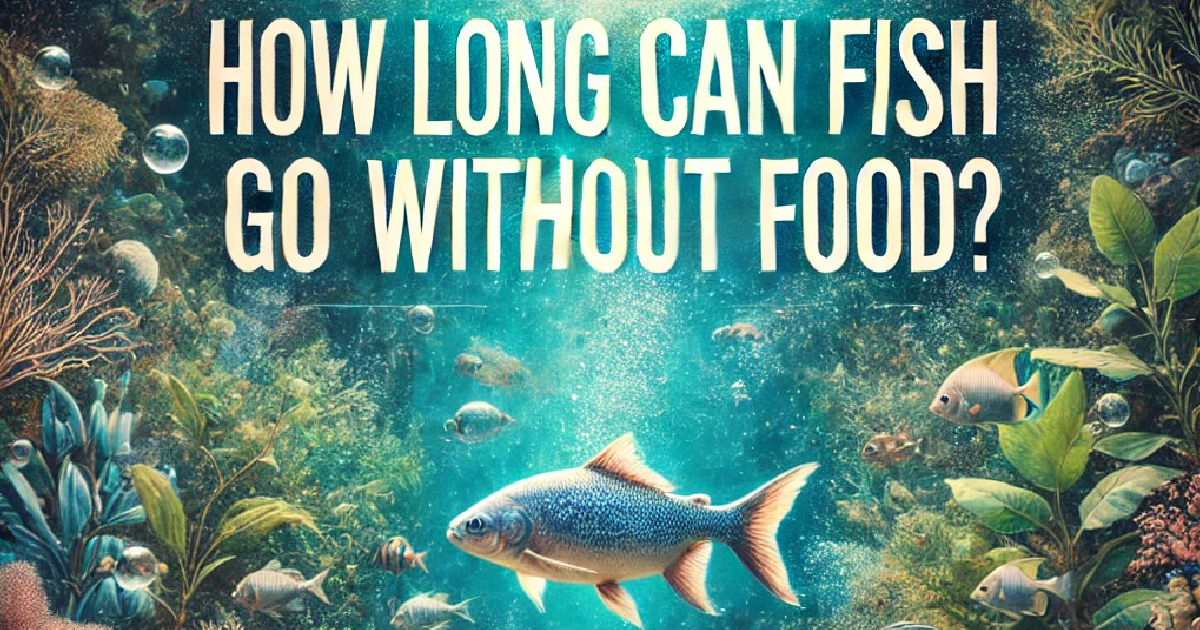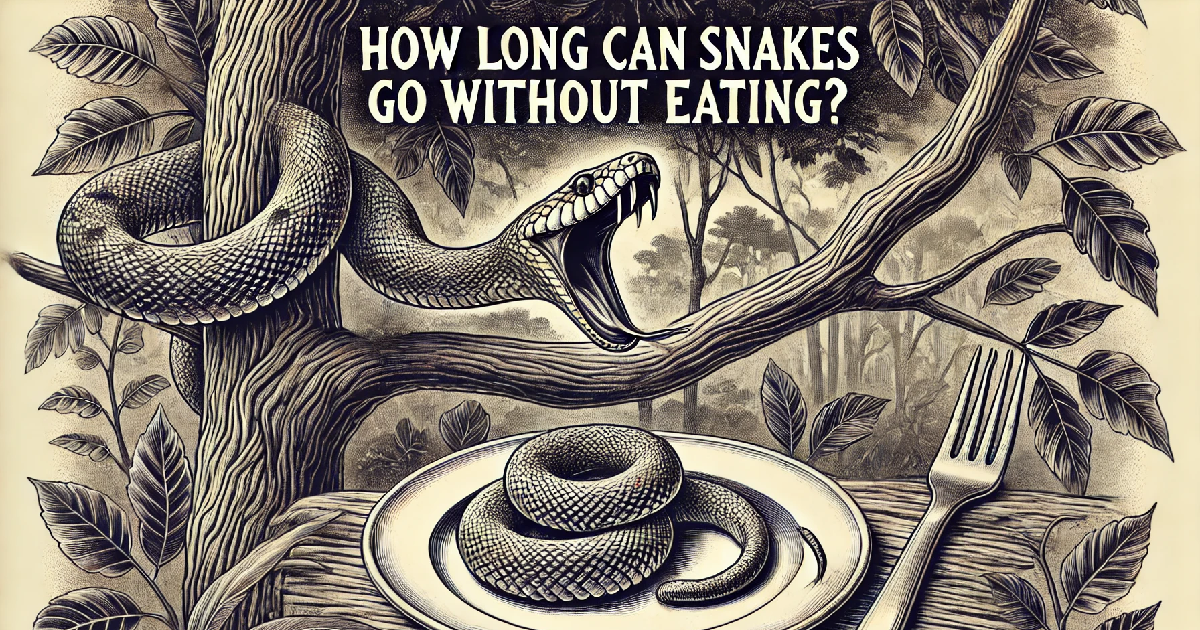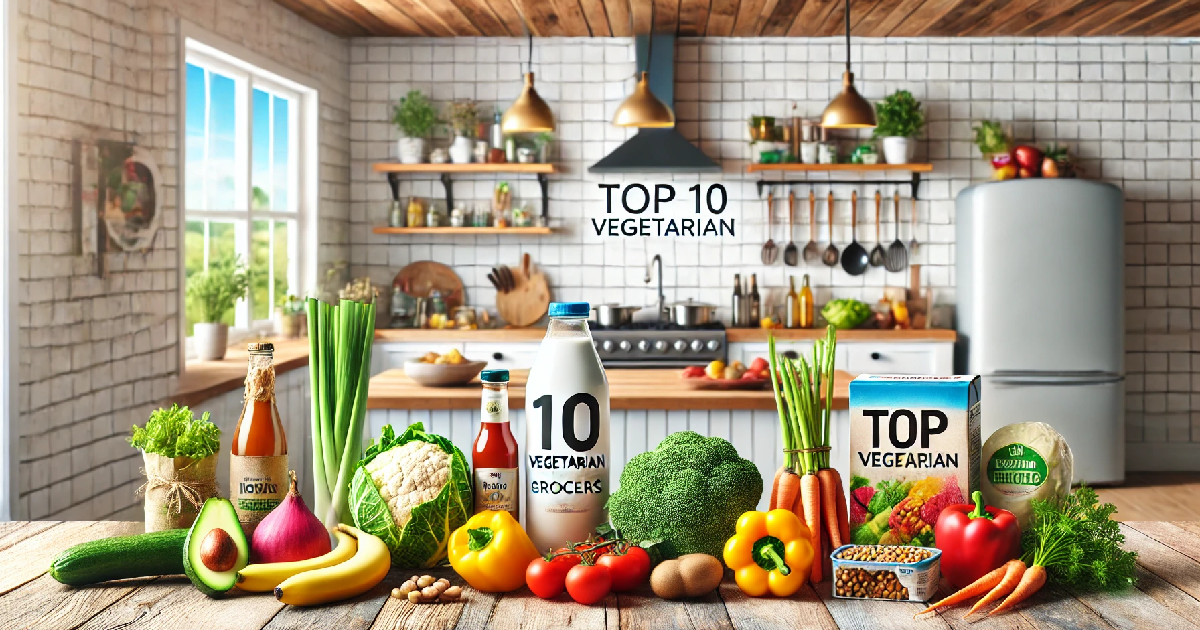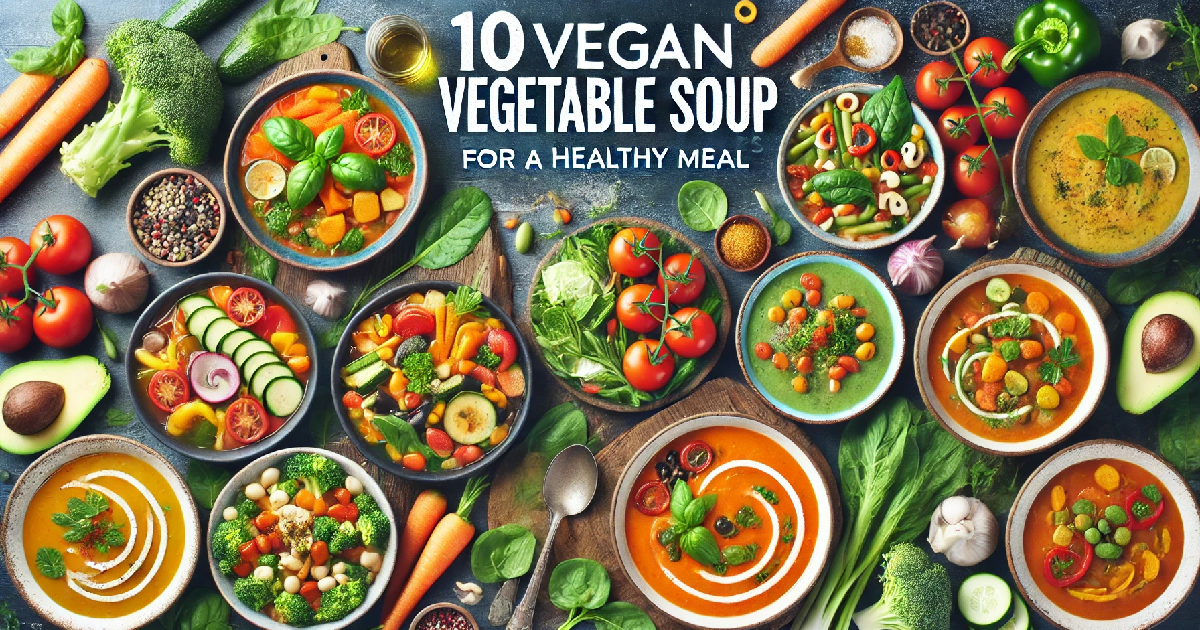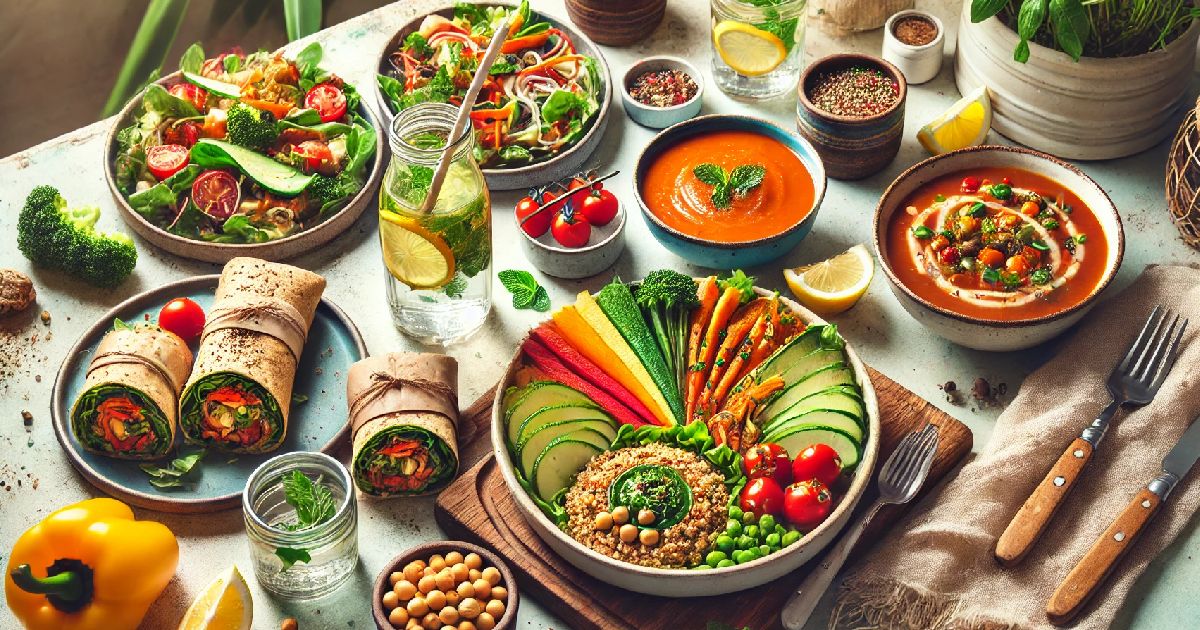Introduction
Are you curious about veganism but need help determining where to begin? You’re not alone. Many people are captivated by the promise of a healthier, more compassionate lifestyle and share the quest to understand how to start becoming vegan. Veganism isn’t just a diet—it’s a revolution that embraces kindness to animals, environmental sustainability, and profound personal health benefits.
Imagine waking up with more energy and knowing your food choices contribute to a healthier planet. Picture yourself enjoying vibrant, delicious meals that nourish your body and align with your values. Transitioning to a vegan lifestyle can be a transformative journey of discovery and self-improvement.
In this guide, “Begin Your Vegan Lifestyle: How to Start,” we’ll walk you through every step of this exciting adventure. Whether you’re driven by ethical concerns, environmental impact, or the desire for better health, we’ve got you covered. From understanding the basics of veganism, finding plant-based alternatives, navigating social situations, and ensuring you’re getting all the necessary nutrients, this comprehensive guide will answer all your questions and more.
So, why is this relevant to you? Choosing veganism is a powerful statement of self-care and environmental responsibility. It’s about making mindful choices that reflect your values and contribute to a better world. By the end of this post, you’ll have the confidence and knowledge to embark on your vegan journey with enthusiasm and ease.
Ready to explore the possibilities? Let’s dive in and discover how to start becoming vegan—one delicious, compassionate step at a time.
How to Start Becoming Vegan
Transitioning to a vegan lifestyle might seem overwhelming at first. However, breaking it down into manageable steps can make the process more approachable and enjoyable.
Understand What Veganism Really Means
Veganism is more than just a diet; it’s a way of living that seeks to exclude all forms of exploitation and cruelty to animals for food, clothing, or any other purpose. This philosophy extends beyond your plate to every aspect of your life. Understanding this broader perspective can help you fully embrace the vegan lifestyle.
Vegans avoid consuming meat, dairy, eggs, and other animal-derived products, including ingredients like gelatin, casein, and certain food colorings. The rationale behind this avoidance is multifaceted, involving concerns for animal welfare, environmental sustainability, and personal health.
By eliminating animal products, vegans aim to reduce their carbon footprint, minimize water usage, and contribute to a decrease in animal suffering. These motivations often reinforce their commitment to the lifestyle, providing a strong foundation for the journey ahead.
Setting Your Vegan Goals
Setting realistic goals is crucial when starting your vegan journey. Begin by assessing your current diet and identifying areas where you can make small, sustainable changes. This gradual approach helps you adapt to new eating habits without feeling deprived or overwhelmed.
Establishing a timeline can be beneficial. For instance, you might start by eliminating red meat in the first month, followed by poultry, fish, dairy, and eggs in subsequent months. This phased approach allows your body and taste buds to adjust gradually, increasing the likelihood of long-term success.
While some people prefer an overnight transformation, it’s perfectly fine to take your time. The key is to stay committed to your goals and celebrate your progress, no matter how small. Remember, the journey to veganism is personal and unique to each individual.
Here’s a sample timeline to help you set your vegan goals:
| Month | Goal |
| 1 | Eliminate red meat |
| 2 | Eliminate poultry |
| 3 | Eliminate fish |
| 4 | Eliminate dairy |
| 5 | Eliminate eggs |
| 6 | Focus on plant-based meals |
Setting achievable goals and progressing at your own pace ensures a smoother transition. This method reduces the likelihood of reverting to old habits and enhances your overall experience.
What is Vegan for Beginners?
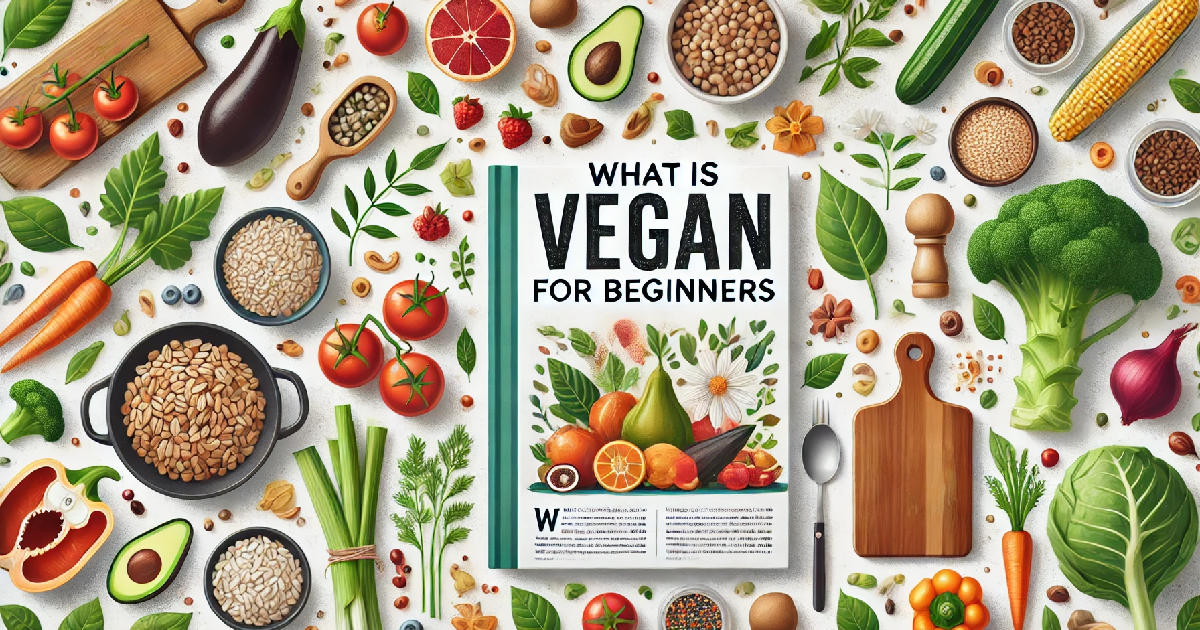
Starting a vegan lifestyle can be both exciting and daunting. As a beginner, you must familiarize yourself with the basics and gradually build your knowledge and skills.
Understand Vegan Labels and Ingredients
One of the first steps in adopting a vegan lifestyle is learning to read food labels. Understanding labels helps you identify non-vegan ingredients hidden in seemingly plant-based products. This skill is crucial for making informed choices and avoiding animal-derived components.
Non-vegan ingredients can sometimes take time to spot. Common non-vegan additives include gelatin, which is made from animal bones and connective tissues. Casein and whey, derived from milk, are often found in processed foods. Another ingredient to watch out for is carmine, a red dye made from crushed insects.
Here’s a helpful table to keep handy while shopping:
| Ingredient | Source |
| Gelatin | Animal bones |
| Casein | Milk |
| Whey | Milk |
| Carmine | Insects |
| Shellac | Insects |
| L-cysteine | Animal feathers |
By familiarizing yourself with these ingredients, you can make more conscious decisions. Always check the ingredient list and look for certified vegan labels to ensure the products align with your dietary choices.
Start with Simple Recipes
Embarking on a vegan journey doesn’t mean you have to become a gourmet chef overnight. Starting with simple, easy-to-make recipes can help ease the transition and build your confidence in the kitchen. These recipes should be quick to prepare and use familiar ingredients.
One great way to start is by organizing your favorite meals. For instance, if you love spaghetti, try making it with a marinara sauce instead of a meat-based sauce. Add vegetables like mushrooms and zucchini for a hearty, satisfying meal. Another simple option is a stir-fry with tofu, mixed vegetables, and a soy-based sauce.
Smoothies are also a beginner-friendly option. Blend fruits, leafy greens, and plant-based milk for a nutritious and delicious breakfast. Overnight oats with almond milk, chia seeds, and your favorite fruits make for a leisurely, prep-ahead breakfast.
Here’s a simple recipe to get you started:
Vegan Avocado Toast:
- Toast a slice of whole-grain bread.
- Mash half an avocado and spread it on the toast.
- Sprinkle with salt, pepper, and a squeeze of lemon juice.
- Top with cherry tomatoes and fresh basil.
Starting with simple recipes helps you build a repertoire of go-to vegan meals. Over time, you’ll gain the confidence to try more complex dishes and expand your culinary horizons.
What are the Steps to Become a Vegan?
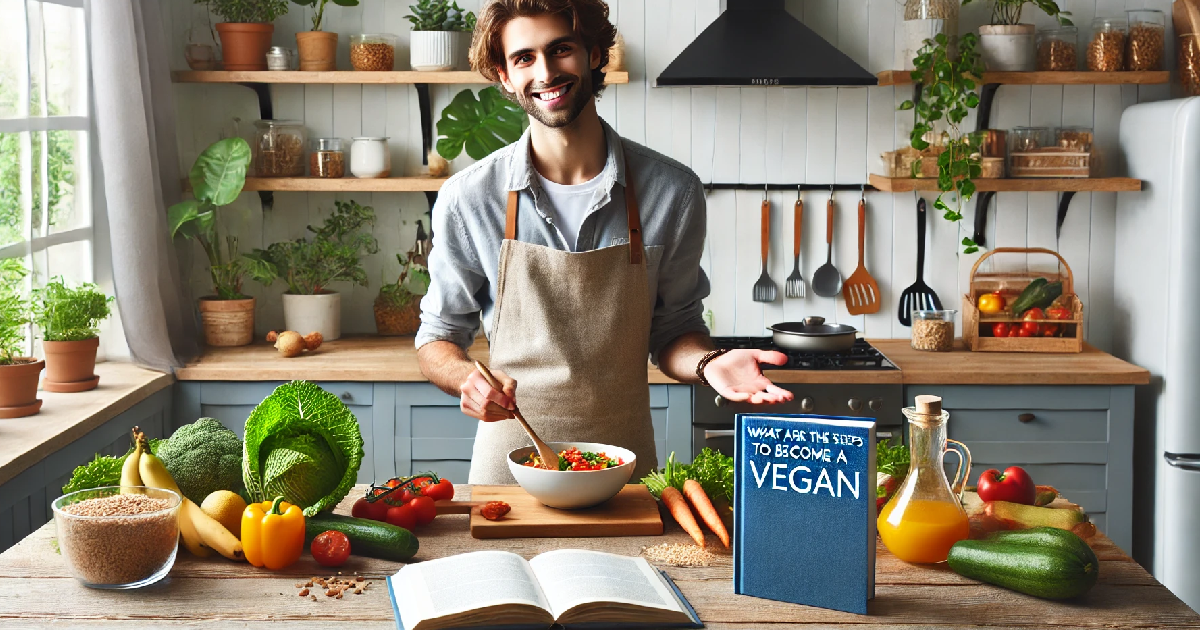
Transitioning to a vegan lifestyle involves several steps. A methodical approach can ensure a smoother and more sustainable change.
Phase Out Animal Products
One effective method for becoming vegan is to gradually phase out animal products. Start by evaluating your current diet and identifying which animal products you consume most frequently. This step allows you to create a manageable and less overwhelming plan.
Begin by eliminating one category of animal products at a time. For example, you might start with red meat. Once you feel comfortable without red meat in your diet, you can move on to poultry, fish, dairy, and eggs. This phased approach gives your body and taste buds time to adjust to new foods and flavors.
A gradual transition can also help you learn and incorporate new cooking techniques. Experimenting with plant-based recipes during this phase can be exciting and rewarding. It ensures you have a variety of delicious meals to choose from, making the transition smoother.
Here’s a sample phased approach:
| Phase | Focus |
| 1 | Eliminate red meat |
| 2 | Eliminate poultry |
| 3 | Eliminate fish |
| 4 | Eliminate dairy |
| 5 | Eliminate eggs |
| 6 | Fully plant-based diet |
By following these phases, you create a sustainable path to veganism. This method reduces the likelihood of feeling deprived and increases your chances of long-term success.
Explore Vegan Alternatives
As you phase out animal products, exploring vegan alternatives is essential. Finding plant-based substitutes for your favorite non-vegan foods can make the transition more enjoyable. Many vegan options are designed to mimic the taste and texture of animal products, making them familiar and satisfying.
For meat alternatives, tofu, tempeh, and seitan can be used in a variety of dishes. These protein-rich foods can replace meat in stir-fries, sandwiches, and salads. Many plant-based meat products are also available that closely resemble the taste and texture of traditional meat.
Dairy alternatives have become increasingly popular and widely available. In most recipes, plant-based milk such as almond, soy, and oat milk can replace cow’s milk. For cheese lovers, numerous vegan cheeses made from nuts, soy, or coconut oil melt and taste similar to dairy cheese.
Egg substitutes can also be found in stores or made at home. Products like flaxseeds or chia seeds mixed with water can replace eggs in baking. Commercial egg replacers are also available that work well in a variety of recipes.
Here’s a comparison table of common vegan alternatives:
| Non-Vegan Food | Vegan Alternative |
| Beef | Tofu, tempeh, seitan |
| Chicken | Plant-based chicken products |
| Cow’s Milk | Almond milk, soy milk, oat milk |
| Cheese | Nut-based cheese, soy cheese |
| Eggs | Flaxseeds, chia seeds, commercial egg replacers |
Exploring these alternatives allows you to continue enjoying your favourite meals. It also helps ensure you maintain a balanced and satisfying diet as you transition to veganism.
Essential Nutrients and Vegan Substitutes
Maintaining a balanced diet is crucial when transitioning to veganism. Understanding the
Essential nutrients and their vegan sources ensure you stay healthy and energized.
Key Nutrients to Focus On
When adopting a vegan diet, focusing on vital nutrients commonly found in animal products is essential. Protein is one of the most discussed nutrients. It is necessary for muscle repair and overall health. Vegan protein sources include beans, lentils, tofu, tempeh, and quinoa. These plant-based proteins can easily be incorporated into a variety of meals.
Iron is another essential nutrient to monitor. It plays a critical role in oxygen transport and energy production. While plant-based sources of iron, such as spinach, lentils, and chickpeas, are abundant, it’s important to pair them with vitamin C-rich foods to enhance absorption. Citrus fruits, bell peppers, and strawberries are excellent sources of vitamin C.
Vitamin B12 is often a concern for vegans because it is primarily found in animal products. It is crucial for nerve function and red blood cell production. Vegans should consider fortified foods, such as plant-based milk and nutritional yeast, or take a B12 supplement to ensure adequate intake.
Calcium, essential for bone health, can be found in fortified plant-based milk, tofu, and leafy green vegetables like kale and bok choy. These sources provide sufficient calcium to meet daily requirements without relying on dairy products.
Here’s a table summarizing these nutrients and their vegan sources:
| Nutrient | Function | Vegan Sources |
| Protein | Muscle repair and growth | Beans, lentils, tofu, tempeh, quinoa |
| Iron | Oxygen transport, energy | Spinach, lentils, chickpeas, fortified cereals |
| B12 | Nerve function, red cells | Fortified plant milks, nutritional yeast |
| Calcium | Bone health | Fortified plant milk, tofu, kale, bok choy |
Focusing on these critical nutrients ensures a well-rounded and nutritious vegan diet. Including a variety of these plant-based foods helps meet nutritional needs and maintain overall health.
Finding the Right Substitutes
Finding the proper vegan substitutes can make the transition smoother and more enjoyable. Meat alternatives like tofu, tempeh, and seitan are versatile and rich in protein. These can be marinated, grilled, or stir-fried to create delicious, meat-like textures and flavors.
Dairy substitutes are widely available and come in various forms. Plant-based milk such as almond, soy, and oat milk can replace cow’s milk in recipes and beverages. Vegan cheeses from nuts, soy, or coconut oil melt and taste similar to traditional cheese, making them great for pizzas, sandwiches, and more.
For those who love eggs, there are several vegan substitutes. Flaxseeds or chia seeds mixed with water create a gel-like consistency that is perfect for baking. Commercial egg replacers are also available and work well in both baking and cooking.
Several brands have gained popularity for their high-quality vegan products. Beyond Meat and Impossible Foods offer plant-based meat alternatives that mimic the taste and texture of beef. For dairy substitutes, brands like Oatly, Silk, and Daiya provide a range of plant-based milks, yogurts, and cheeses. Just Egg and Follow Your Heart are popular choices for egg replacements.
Here’s a table with common non-vegan foods and their vegan substitutes:
| Non-Vegan Food | Vegan Substitute | Popular Brands |
| Beef | Tofu, tempeh, seitan | Beyond Meat, Impossible Foods |
| Cow’s Milk | Almond milk, soy milk, oat milk | Oatly, Silk, Almond Breeze |
| Cheese | Nut-based cheese, soy cheese | Daiya, Follow Your Heart |
| Eggs | Flaxseeds, chia seeds, egg replacers | Just Egg, Bob’s Red Mill |
Exploring these substitutes allows you to continue enjoying your favorite foods. It ensures your diet remains satisfying and nutritionally balanced as you transition to veganism.
How do you start a vegan journey?
Starting a vegan journey involves more than just changing your diet. It’s about building a supportive community and learning new skills to make the transition enjoyable and sustainable.
Connect with Vegan Communities
Connecting with vegan communities is one of the best ways to start your vegan journey. These groups can provide invaluable support, advice, and camaraderie. You can find local vegan groups through social media platforms like Facebook or Meetup. These groups often organize events such as potlucks, cooking classes, and restaurant outings, which can be a great way to meet like-minded people and learn from their experiences.
Online communities are also a fantastic resource. Websites and forums like Reddit, The Vegan Society, and Vegan Forum offer a wealth of information and a place to ask questions and share experiences. These communities can be beneficial if you live in an area with few local vegan options.
Participating in these communities helps you stay motivated and inspired. Hearing stories from others who have successfully transitioned to veganism can be encouraging. It also provides a space to discuss challenges and find solutions together.
Here’s a table summarizing ways to connect with vegan communities:
| Type | Platforms/Resources | Benefits |
| Local Groups | Facebook, Meetup | Social events, local advice |
| Online Communities | Reddit, The Vegan Society, Vegan Forum | Global advice, diverse experiences |
Connecting with these communities can help you build a support network that can make your vegan journey smoother and more enjoyable.
Learn Vegan Cooking Basics
Learning the basics of vegan cooking is essential for a successful transition. Start by familiarizing yourself with staple ingredients like beans, lentils, tofu, tempeh, and a variety of vegetables. These ingredients form the foundation of many vegan meals and are versatile and nutritious.
Begin with simple recipes to build your confidence. For example, a basic stir-fry with tofu and vegetables or a hearty lentil soup can be satisfying and easy to prepare. You can explore more complex recipes and cooking techniques as you become more comfortable.
It is also important to stock your pantry with essential vegan ingredients. Items like nutritional yeast, which adds a cheesy flavor to dishes, and a variety of herbs and spices can elevate your meals. Whole grains such as quinoa, brown rice, and oats should also be staples in your kitchen.
Taking a vegan cooking class can be a fun and educational experience. Many local community centers and online platforms offer courses that teach you how to prepare delicious vegan meals. These classes can provide hands-on experience and introduce you to new ingredients and techniques.
Here’s a sample list of essential vegan pantry items:
| Ingredient | Uses |
| Beans and Lentils | Soups, stews, salads |
| Tofu and Tempeh | Stir-fries, sandwiches, grilling |
| Nutritional Yeast | Sauces, seasoning, vegan cheese |
| Whole Grains | Side dishes, salads, breakfast bowls |
| Herbs and Spices | Flavor enhancement |
Learning vegan cooking basics empowers you to create various delicious and nutritious meals. It also ensures you have the skills and ingredients to maintain a balanced vegan diet.
How to Slowly Start Going Vegan?
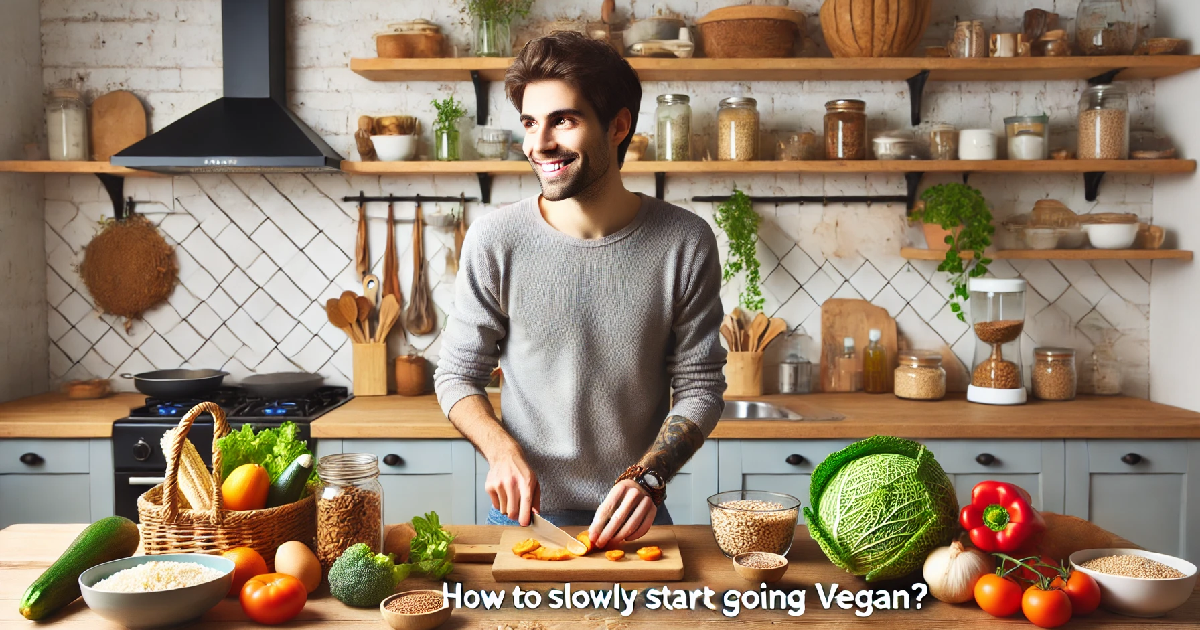
Transitioning to a vegan lifestyle doesn’t have to be abrupt. Gradually incorporating vegan practices can make the change more manageable and sustainable.
Implement Meatless Mondays
One effective strategy to start your vegan journey is by implementing Meatless Mondays. This concept involves dedicating one day a week to eating entirely plant-based meals. Starting with just one day, you can explore vegan recipes and get comfortable with plant-based cooking without feeling overwhelmed.
Meatless Mondays can help you discover new foods and flavors. Use this day to experiment with different plant-based proteins such as beans, lentils, tofu, and tempeh. Trying new vegetables, grains, and legumes can also expand your culinary repertoire. Over time, you will enjoy these plant-based meals and look forward to them each week.
This gradual approach allows your body to adjust to the new diet. It can also help you identify any challenges or preferences you have regarding vegan foods. By taking it one day at a time, you can ease into a fully vegan lifestyle at a pace that suits you.
Here’s a sample Meatless Monday meal plan:
| Meal | Example |
| Breakfast | Smoothie bowl with fruits and nuts |
| Lunch | Quinoa salad with chickpeas and vegetables |
| Dinner | Stir-fry with tofu, broccoli, and rice |
| Snack | Hummus with carrot sticks |
Starting with Meatless Mondays can build a solid foundation for your vegan journey. It allows you to make gradual changes and develop a taste for plant-based foods.
Increase Vegan Meal Frequency Gradually
Once you’re comfortable with Meatless Mondays, the next step is gradually increasing the frequency of your vegan meals. This method helps you adapt to a vegan diet without feeling pressured to make a sudden, drastic change. Add another vegan day to your week, such as a “Tofu Tuesday.” Gradually increase the number of vegan days each week until you eat plant-based meals more often.
As you increase the frequency, try to incorporate a variety of vegan dishes to keep your meals interesting. Explore different vegan cuisines, like Indian, Mediterranean, and Mexican. This variety ensures you get a broad range of nutrients and flavors, making the transition more enjoyable.
Tracking your progress can be helpful. Keep a journal of your meals and note how you feel physically and emotionally. This record can provide motivation and highlight the positive changes you’re experiencing. It can also help you identify any areas where you might need to adjust your diet to ensure
It’s balanced and satisfying.
Here’s a sample plan for increasing vegan meal frequency:
| Week | Vegan Days |
| 1-2 | Meatless Monday |
| 3-4 | Meatless Monday, Tofu Tuesday |
| 5-6 | Add Vegan Thursday |
| 7-8 | Add Vegan Saturday |
Following this gradual increase, you likely find that transitioning to a fully vegan lifestyle is a natural progression. This approach minimizes stress and allows your body and palate to adapt comfortably.
How do you start off being a vegan?
Embarking on a vegan journey can be a fulfilling and transformative experience. The key is to start with a solid foundation and gradually build your knowledge and skills.
Educate Yourself About Veganism
The first step in becoming a vegan is to educate yourself about it. Understanding the ethical, environmental, and health aspects of veganism is crucial. Ethically, veganism seeks to reduce animal suffering by avoiding animal products. This choice is driven by the belief that animals should not be exploited for food, clothing, or other purposes.
Environmentally, adopting a vegan lifestyle can significantly reduce your carbon footprint. Animal agriculture is a leading cause of deforestation, water pollution, and greenhouse gas emissions. By choosing plant-based foods, you contribute to a more sustainable and eco-friendly planet.
Veganism can offer numerous health benefits. A well-planned vegan diet is rich in fruits, vegetables, whole grains, and legumes, and it is associated with lower risks of chronic diseases such as heart disease, diabetes, and certain cancers. However, it is important to ensure you get all the necessary nutrients, such as protein, iron, calcium, and B12.
Educating yourself through books, documentaries, and reputable websites can provide a comprehensive understanding of veganism. Resources like “The Vegan Society” and documentaries such as “Forks Over Knives” and “Cowspiracy” offer valuable insights. This knowledge will empower you to make informed choices and stay committed to your new lifestyle.
Begin with Familiar Foods
Starting your vegan journey with familiar foods can make the transition smoother. One effective strategy is to veganize dishes you already love. For example, if spaghetti Bolognese is a favorite, you can replace the meat with lentils or a plant-based meat alternative. This way, you can continue enjoying your favorite meals while aligning with your new dietary choices.
Exploring plant-based versions of common ingredients is also helpful. For example, swap cow’s milk for almond, soy, or oat milk in your coffee and cereal. Use nutritional yeast as a cheesy topping for pasta and popcorn. Experimenting with these substitutes lets you maintain the flavors and textures you enjoy.
Focusing on simple and easy-to-make recipes can help you build confidence in your vegan cooking skills. Start with recipes that require minimal ingredients and steps, such as stir-fries, salads, and smoothies. As you become more comfortable, you can gradually try more complex dishes.
Here’s a comparison table for common non-vegan ingredients and their vegan alternatives:
| Non-Vegan Ingredient | Vegan Alternative |
| Ground Beef | Lentils, plant-based meat |
| Cow’s Milk | Almond milk, soy milk, oat milk |
| Cheese | Nutritional yeast, vegan cheese |
| Eggs | Flaxseeds, chia seeds, tofu |
Beginning with familiar foods helps ease the transition and makes the idea of a vegan diet less daunting. It allows you to discover the vast array of delicious plant-based options available. This approach ensures that your journey into veganism starts on a positive and enjoyable note.
Planning Your Vegan Diet
Planning your vegan diet is essential to ensure you get all the necessary nutrients and enjoy various delicious meals. This involves mastering vegan cooking and learning effective meal planning and prepping techniques.
Mastering Vegan Cooking
Mastering vegan cooking starts with understanding basic techniques and essential ingredients. Standard methods include sautéing, roasting, steaming vegetables, and preparing grains and legumes. Familiarize yourself with key ingredients such as tofu, tempeh, beans, lentils, and various vegetables. These staples form the foundation of many vegan dishes.
Experiment with different spices and herbs to enhance flavors. For instance, nutritional yeast can add a cheesy flavor to dishes, while spices like cumin, paprika, and turmeric can bring depth to your meals. Start with simple recipes such as a basic stir-fry with tofu and vegetables or a hearty lentil soup. These dishes are easy to prepare and can be customized with your favorite ingredients.
Simple recipes are a great way to build confidence in the kitchen. Try a chickpea salad sandwich using mashed chickpeas, vegan mayo, and your choice of veggies. Another easy dish is a vegetable curry made with coconut milk, your favorite vegetables, and a blend of spices. These recipes are delicious and quick to prepare, making them perfect for beginners.
Here’s a sample simple vegan recipe:
Easy Vegan Stir-Fry:
- Sauté diced tofu in a pan with olive oil until golden brown.
- Add chopped vegetables such as bell peppers, broccoli, and snap peas.
- Stir in soy sauce, garlic, and ginger.
- Serve over brown rice or quinoa.
Meal Planning and Prepping
Meal planning and prepping are crucial for maintaining a balanced vegan diet. Start by planning your meals for the week. This helps ensure you have a variety of dishes and reduces the temptation to reach for non-vegan options. Make a shopping list based on your meal plan to streamline grocery shopping.
When planning your meals, aim to balance proteins, carbohydrates, and healthy fats. Incorporate a variety of fruits, vegetables, whole grains, and legumes to cover all essential nutrients. Prepping ingredients ahead of time can save you significant time during the week. For example, chop vegetables, cook grains, and prepare sauces in advance.
Set aside a few hours each week to batch-cook meals. Store them in portioned containers for easy access. This method ensures you always have a healthy meal ready, which is especially helpful on busy days. Here’s a sample meal plan for a week:
| Day | Breakfast | Lunch | Dinner |
| Monday | Smoothie bowl | Chickpea salad wrap | Tofu stir-fry |
| Tuesday | Overnight oats | Lentil soup | Vegetable curry |
| Wednesday | Avocado toast | Quinoa salad | Black bean tacos |
| Thursday | Vegan pancakes | Hummus and veggie wrap | Spaghetti with marinara |
| Friday | Chia pudding | Buddha bowl | Stuffed bell peppers |
| Saturday | Vegan scrambled eggs | Vegan sushi | Sweet potato chili |
| Sunday | Fruit salad and nuts | Vegan burrito bowl | Eggplant parmesan |
By planning and prepping your meals, you ensure a nutritionally balanced diet. It also makes sticking to veganism easier and more enjoyable.
What do vegans eat for breakfast?
Breakfast is an important meal, and plenty of vegan options are available to start your day right.
Vegan Breakfast Staples
Everyday vegan breakfast includes fruits, whole grains, nuts, seeds, and plant-based milk. These ingredients are versatile and can be used in a variety of dishes. Oats are popular, whether as traditional oatmeal, overnight oats, or added to smoothies for extra texture and nutrition.
Another staple is tofu, which can be scrambled to mimic eggs. This provides a protein-rich start to your day. Avocado is also a favorite for its healthy fats and can be spread on toast or added to smoothies for a creamy texture.
Nuts and seeds like almonds, chia seeds, and flaxseeds are nutrient-dense additions to any breakfast. They can be sprinkled on oatmeal, blended into smoothies, or mixed into granola.
Quick Vegan Breakfast Ideas
For busy mornings, quick vegan breakfast recipes can save time while being nutritious and delicious. Smoothies are a fast and versatile option. Blend fruits like bananas and berries with spinach, almond milk, and a spoonful of peanut butter for a nutrient-packed drink.
Overnight oats are another convenient choice. Mix oats with plant-based milk and your favorite toppings, such as chia seeds, nuts, and fruits. Let it sit in the fridge overnight, and you’ll have a ready-to-eat breakfast in the morning.
Avocado toast is a quick and satisfying breakfast. Mash an avocado and spread it on whole-grain toast. Top with salt, pepper, and a squeeze of lemon juice. For added protein, sprinkle some hemp seeds or nutritional yeast on top.
Here’s a simple vegan breakfast recipe:
Chia Seed Pudding:
- Mix 3 tablespoons of chia seeds with 1 cup of almond milk.
- Add a teaspoon of maple syrup and vanilla extract.
- Stir well and refrigerate overnight.
- In the morning, top with fresh berries and nuts.
Navigating Social and Lifestyle Changes
Adopting a vegan lifestyle involves more than just changing your diet. It also requires navigating social situations and dealing with potential criticism.
Eating Out and Social Events
Eating out and attending social events as a vegan can be challenging but manageable with some preparation. Researching restaurants beforehand can help you find vegan-friendly options. Many restaurants now offer vegan dishes or can modify existing menu items to accommodate your diet.
When attending social events, it’s helpful to inform the host of your dietary preferences in advance. Offering to bring a vegan dish can ensure there’s something you can eat while also introducing others to delicious plant-based food. Learning to ask questions about
Ingredients and being transparent about your dietary needs are crucial.
Traveling as a vegan requires more planning. Packing snacks like nuts, dried fruits, and protein bars can help you avoid non-vegan options. Researching vegan-friendly restaurants and stores at your destination ahead of time can make your trip more enjoyable.
Dealing with Criticism and Questions
Dealing with criticism and questions about your vegan lifestyle is part of the journey. People may have misconceptions or be curious about your choices. Responding calmly and informatively can help educate others and reduce misunderstandings.
Prepare to answer common questions like, “Where do you get your protein?” or “Isn’t a vegan diet expensive?” Having well-informed responses can make these interactions more positive. Emphasize the personal benefits you’ve experienced, such as improved health and a sense of alignment with your values.
Maintaining your lifestyle in a non-vegan world can be challenging, but staying connected to vegan communities can provide support. These groups offer an incredibly valuable sense of belonging and understanding. Surrounding yourself with like-minded individuals can reinforce your commitment and provide a supportive environment.
By navigating these social and lifestyle changes with preparation and confidence, you can maintain your vegan lifestyle successfully. It lets you stay true to your values while enjoying social interactions and new experiences.
Conclusion
Starting a vegan lifestyle is a journey of discovery, growth, and positive change. You can transition smoothly and enjoyably by educating yourself about veganism, phasing out animal products, and exploring delicious plant-based alternatives. Planning your vegan diet and mastering vegan cooking will ensure you receive all the essential nutrients while savoring various flavors and textures. Additionally, connecting with vegan communities and learning to navigate social situations will provide the support and confidence you need to maintain your new lifestyle.
As you embark on this path, remember there is no one-size-fits-all approach to becoming vegan. Take it at your own pace, make gradual changes, and celebrate each step forward. The journey is personal and unique, and finding your own rhythm is okay. Embrace the learning process and the opportunity to experiment with new foods and recipes. Enjoy the health benefits, peace of mind, and sense of purpose that come with aligning your lifestyle with your values.
To further enrich your journey, immerse yourself in additional resources. Read books, watch documentaries, and join online or local vegan communities. These resources can provide ongoing inspiration, information, and support. They will help you stay informed and connected, making your vegan lifestyle more sustainable and rewarding.
Adopting a vegan lifestyle is a powerful statement in a world where our choices impact the environment, animal welfare, and our health. It’s a commitment to living more consciously and compassionately. As you explore veganism, consider the broader implications of your choices. Reflect on how each meal can be a step toward a more sustainable and humane world.
So, take the first step today. Embrace the journey, savor the discoveries, and join a growing community dedicated to making a positive difference. Your choice to go vegan is more than a dietary change—it’s a meaningful contribution to a better future. What will your next meal say about the world you want to create?
FAQs
1. Is veganism expensive?
Veganism doesn’t have to be expensive. Plant-based staples like beans, lentils, rice, and vegetables are some of the most affordable foods. To keep costs low, buy in bulk, shop at local farmers’ markets, and focus on whole foods rather than processed vegan products. Planning your meals and preparing food at home can also save money. Many resources and budget-friendly vegan recipes are available online to help you eat well without breaking the bank.
2. How do I ensure I’m getting enough protein?
Ensuring adequate protein intake on a vegan diet is simple with various plant-based sources. Foods like lentils, chickpeas, tofu, tempeh, quinoa, and edamame are rich in protein. Incorporating a mix of these into your meals ensures you get enough protein. For example, add beans to your salads, enjoy a tofu stir-fry for dinner, or eat hummus with veggies. Diversifying your diet with different protein sources will help meet your nutritional needs.
3. Can I be vegan even if my family isn’t?
Yes, you can be vegan even if your family isn’t. It may require some extra planning and communication, but it is feasible. One strategy is to prepare base meals for everyone, with vegan components for you and optional non-vegan additions for others. For example, make a large salad or pasta dish and let each family member customize their portion. Sharing your vegan dishes can also introduce your family to delicious plant-based foods and foster a more inclusive mealtime.
4. What should I do if I slip up?
Slipping up is a common experience when transitioning to a vegan lifestyle. It’s important to be kind to yourself and view it as part of the learning process. Reflect on what led to the slip-up and how you can prevent it in the future. Use it as an opportunity to reaffirm your commitment to veganism. Remember, every meal is a new chance to make a vegan choice. Focus on your progress rather than perfection, and seek support from vegan communities if you need encouragement.
5. Are there vegan options at fast food restaurants?
Many fast-food restaurants now offer vegan options. Chains like Burger King, Taco Bell, and Subway have plant-based menu items or can customize orders to be vegan. For example, you can order a veggie burger without cheese or mayo at Burger King or a bean burrito without cheese at Taco Bell. When in doubt, check the restaurant’s website for nutritional information or ask staff about vegan-friendly modifications. Being prepared and knowing what to look for makes eating out as a vegan much easier.








